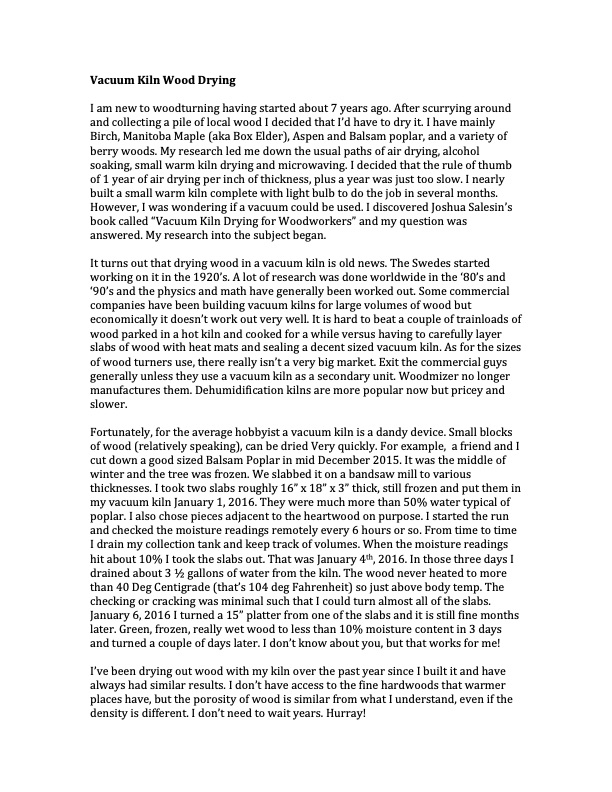
PDF Publication Title:
Text from PDF Page: 001
Vacuum Kiln Wood Drying I am new to woodturning having started about 7 years ago. After scurrying around and collecting a pile of local wood I decided that I’d have to dry it. I have mainly Birch, Manitoba Maple (aka Box Elder), Aspen and Balsam poplar, and a variety of berry woods. My research led me down the usual paths of air drying, alcohol soaking, small warm kiln drying and microwaving. I decided that the rule of thumb of 1 year of air drying per inch of thickness, plus a year was just too slow. I nearly built a small warm kiln complete with light bulb to do the job in several months. However, I was wondering if a vacuum could be used. I discovered Joshua Salesin’s book called “Vacuum Kiln Drying for Woodworkers” and my question was answered. My research into the subject began. It turns out that drying wood in a vacuum kiln is old news. The Swedes started working on it in the 1920’s. A lot of research was done worldwide in the ‘80’s and ‘90’s and the physics and math have generally been worked out. Some commercial companies have been building vacuum kilns for large volumes of wood but economically it doesn’t work out very well. It is hard to beat a couple of trainloads of wood parked in a hot kiln and cooked for a while versus having to carefully layer slabs of wood with heat mats and sealing a decent sized vacuum kiln. As for the sizes of wood turners use, there really isn’t a very big market. Exit the commercial guys generally unless they use a vacuum kiln as a secondary unit. Woodmizer no longer manufactures them. Dehumidification kilns are more popular now but pricey and slower. Fortunately, for the average hobbyist a vacuum kiln is a dandy device. Small blocks of wood (relatively speaking), can be dried Very quickly. For example, a friend and I cut down a good sized Balsam Poplar in mid December 2015. It was the middle of winter and the tree was frozen. We slabbed it on a bandsaw mill to various thicknesses. I took two slabs roughly 16” x 18” x 3” thick, still frozen and put them in my vacuum kiln January 1, 2016. They were much more than 50% water typical of poplar. I also chose pieces adjacent to the heartwood on purpose. I started the run and checked the moisture readings remotely every 6 hours or so. From time to time I drain my collection tank and keep track of volumes. When the moisture readings hit about 10% I took the slabs out. That was January 4th, 2016. In those three days I drained about 3 1⁄2 gallons of water from the kiln. The wood never heated to more than 40 Deg Centigrade (that’s 104 deg Fahrenheit) so just above body temp. The checking or cracking was minimal such that I could turn almost all of the slabs. January 6, 2016 I turned a 15” platter from one of the slabs and it is still fine months later. Green, frozen, really wet wood to less than 10% moisture content in 3 days and turned a couple of days later. I don’t know about you, but that works for me! I’ve been drying out wood with my kiln over the past year since I built it and have always had similar results. I don’t have access to the fine hardwoods that warmer places have, but the porosity of wood is similar from what I understand, even if the density is different. I don’t need to wait years. Hurray!PDF Image | Vacuum Kiln Wood Drying

PDF Search Title:
Vacuum Kiln Wood DryingOriginal File Name Searched:
Vacuum-Kiln-Wood-Drying-PDF.pdfDIY PDF Search: Google It | Yahoo | Bing
5,000 BF Shipping Container Lumber Dry Kiln For Quality Lumber The 5,000 BF container kiln consists of one 40 foot high-cube aluminum shipping container... More Info
Shipping Container Lumber Dry Kilns by Global Energy Global Energy designed and developed the container kiln back in 1991. The purpose is to give access to portable sawmill owners, furniture makers, and small business the value added profit of dry kiln lumber and quality hardwoods... More Info
Vacuum Kiln Conversion Kit for Lumber and Wood Dry Kilns Convert your existing conventional dry kiln into a fast drying vacuum kiln. Similar to vacuum bagging in the boat building and aircraft industry, we have come up with a proprietary process which allows you to build a very simple vacuum kiln at a fraction of the price, and without the intensive conventional metal chamber structure... More Info
Vacuum Pump Cart System for Bagging Clamping Wood Drying and more Vacuum Cart with 2HP Pump and Dual Pistons with multiple multiplex vacuum ports and liquid reservoir... More Info
Vacuum Bagging Basics Vacuum bagging is a method of clamping, which has traditionally been used in the composites industry, but can also be used for vacuum drying materials, including wood products... More Info
| CONTACT TEL: 608-238-6001 Email: greg@globalmicroturbine.com | RSS | AMP |